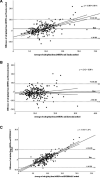Comparison of three spot urine formulae and their validation using 24-hour urine sodium for estimation of daily salt intake: a cross-sectional study among Bangladeshi adults
- PMID: 36581969
- PMCID: PMC9438190
- DOI: 10.1136/bmjopen-2022-061348
Comparison of three spot urine formulae and their validation using 24-hour urine sodium for estimation of daily salt intake: a cross-sectional study among Bangladeshi adults
Abstract
Objective: This study aimed to assess the validity of three commonly used (Tanaka, Kawasaki, INTERSALT) methods based on spot urinary sodium excretion against the 24-hour urinary sodium excretion to estimate the dietary salt intake in Bangladesh.
Design: A population-based cross-sectional survey.
Setting: A cross-sectional survey was done in an urban and a rural area of Bangladesh in 2012-2013.
Participants: 418 community living residents aged 40-59 years participated in the survey and data of 227 subjects who had complete information were analysed for this validation study.
Outcome measures: The Bland-Altman method was used to evaluate the agreement between the estimated and measured 24-hour urinary sodium. The estimated average salt intake from Tanaka, Kawasaki and INTERSALT methods were plotted against 24-hour urinary sodium excretion.
Results: The mean 24-hour estimated salt intake was 10.0 g/day (95% CI 9.3 to 10.6). The mean estimated urinary salt by Tanaka, Kawasaki and INTERSALT methods were 8.5 g/day (95% CI 8.2 to 8.8), 11.4 g/day (95% CI 10.8 to 12.0) and 8.8 g/day (95% CI 8.6 to 9.0), respectively. Compared with the estimated mean salt intake from 24-hour urine collection, the Bland-Altman plot indicated the mean salt intake was overestimated by the Kawasaki method and underestimated by Tanaka and INTERSALT methods. The linear regression line showed the Kawasaki method was the least biased and had the highest intraclass correlation coefficient (0.57, 95% CI 0.45 to 0.67).
Conclusion: Tanaka, Kawasaki and INTERSALT methods were not appropriate for the estimation of 24-hour urinary sodium excretion from spot urine samples to assess dietary salt intake in Bangladesh. Among the three methods, the Kawasaki method has the highest agreement with the 24-hour urinary sodium excretion concentration in this population.
Keywords: CARDIOLOGY; NUTRITION & DIETETICS; PUBLIC HEALTH.
© Author(s) (or their employer(s)) 2022. Re-use permitted under CC BY-NC. No commercial re-use. See rights and permissions. Published by BMJ.
Conflict of interest statement
Competing interests: None declared.
Figures
Similar articles
-
Validation and Assessment of Three Methods to Estimate 24-h Urinary Sodium Excretion from Spot Urine Samples in High-Risk Elder Patients of Stroke from the Rural Areas of Shaanxi Province.Int J Environ Res Public Health. 2017 Oct 11;14(10):1211. doi: 10.3390/ijerph14101211. Int J Environ Res Public Health. 2017. PMID: 29019912 Free PMC article. Clinical Trial.
-
Assessment and validation of three spot urine assay methods for the estimation of 24-hour urinary sodium excretion in Chinese Tibetan adults living in the mountains.J Clin Hypertens (Greenwich). 2021 Aug;23(8):1588-1598. doi: 10.1111/jch.14312. Epub 2021 Jul 1. J Clin Hypertens (Greenwich). 2021. PMID: 34196446 Free PMC article.
-
Validation of spot urine in estimating 24-h urinary sodium, potassium and sodium-to-potassium ratio during three different sodium diets in healthy adults.Blood Press. 2023 Dec;32(1):2170868. doi: 10.1080/08037051.2023.2170868. Blood Press. 2023. PMID: 36752063
-
Evaluation of three prediction formulas of 24-hour urinary sodium excretion in Chinese residents: a systematic review and meta-analysis.Public Health Nutr. 2024 Feb 2;27(1):e71. doi: 10.1017/S1368980024000168. Public Health Nutr. 2024. PMID: 38305112 Free PMC article.
-
The Use and Interpretation of Sodium Concentrations in Casual (Spot) Urine Collections for Population Surveillance and Partitioning of Dietary Iodine Intake Sources.Nutrients. 2016 Dec 23;9(1):7. doi: 10.3390/nu9010007. Nutrients. 2016. PMID: 28025546 Free PMC article. Review.
Cited by
-
Salt intake across the hypertension care cascade in the Bangladeshi adult population: a nationally representative cross-sectional study.BMJ Open. 2024 Apr 5;14(4):e081913. doi: 10.1136/bmjopen-2023-081913. BMJ Open. 2024. PMID: 38580369 Free PMC article.
-
Urinary Sodium and Potassium Excretion in Bangladeshi Adults: Results from a Population-Based Survey with 24-Hour Urine Collections.Glob Heart. 2025 Jul 14;20(1):62. doi: 10.5334/gh.1447. eCollection 2025. Glob Heart. 2025. PMID: 40686567 Free PMC article.
-
Associations and mediators of estimated sodium intake with cardiovascular mortality: data based on a national population cohort.BMC Med. 2025 Jul 1;23(1):392. doi: 10.1186/s12916-025-04206-8. BMC Med. 2025. PMID: 40597235 Free PMC article.
-
Influence of Dietary Heritage in a Restricted Geographic Area and Role of Food Additives on Risk of Recurrent Kidney Stone.Nutrients. 2024 Sep 4;16(17):2984. doi: 10.3390/nu16172984. Nutrients. 2024. PMID: 39275299 Free PMC article.
References
-
- GBD 2017 Causes of Death Collaborators . Global, regional, and national age-sex-specific mortality for 282 causes of death in 195 countries and territories, 1980-2017: a systematic analysis for the global burden of disease study 2017. Lancet 2018;392:1736-1788. 10.1016/S0140-6736(18)32203-7 - DOI - PMC - PubMed
-
- Institute for Health Metrics and Evaluation (IHME) . Bangladesh profile. Seattle, WA: IHME, University of Washington, 2018. Available: http://www.healthdata.org/Bangladesh [Accessed 20 Jul 202].
Publication types
MeSH terms
Substances
LinkOut - more resources
Full Text Sources
Medical

